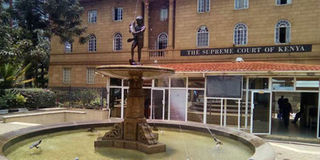Recent judicial audit should have covered all sectors of court system

The Supreme Court building in Nairobi. PHOTO | DOUGLAS KIEREINI | NATION MEDIA GROUP
What you need to know:
A proper audit should be carried out to address the disparity in terms of allocation of judges.
In Malindi, for instance, many a time appeals are heard and determined within the year they are filed.
The most affected of all the courts is the Chief Magistrate’s Commercial Courts, Milimani, and the Nairobi High Court, where it can at times take years to obtain proceedings.
Although the recent judicial audit report released by Chief Justice David Maraga is a reflection of the gains made in the Judiciary.
However, a lot more needs to be done to address the case backlog in the courts with the optimum target of hearing and determining cases within a year.
The report reflected general progress and milestones but certain aspects of the audit were not realistic. While the great achievements in the Court of Appeal should be appreciated, as it is now possible, even in Nairobi, for appeals to be determined within two years while it would take up to 10 years.
But that is not the case in the Nairobi Environment and Land Court, where getting a mention date, leave alone being granted a hearing date, is a tall order.
ADDITIONAL JUDGES
It is not understandable why this should be happening at a time when so many additional judges have progressively been appointed since the promulgation of the 2010 Constitution.
In contrast, courts outside Nairobi have readily available hearing dates at short notice.
It is, for example, much easier to obtain a hearing date in Machakos, Migori or Wote and have your case heard at the earliest opportunity than in Nairobi, where a mention date any earlier than four months could be a great achievement.
A proper audit should, therefore, be carried out to address the disparity in terms of allocation of judges to this important court, if that is the cause of the problem in Nairobi, so that additional judges are posted.
However, in the Murang’a High Court, there were no dates in the Family registry as at March 2018 — not even a mention date for the year — while the diary for 2019 is yet to be opened and no dates can be given. All cases are, therefore, left in abeyance.
APPELLATE COURTS
The report was, however, reflective of the true status of Appellate Courts. In Malindi, for instance, many a time appeals are heard and determined within the year they are filed. It should be appreciated that this has always happened when there has all along been only one Bench of three judges.
Malindi could, perhaps, be the second-busiest Court of Appeal station, after Nairobi, as it handles appeals from the entire Coast region, including the port city of Mombasa.
The Judiciary should also direct more attention to improving and making typed proceedings readily available as that is a major hindrance to the hearing of appeals, both in the High Court and the Court of Appeal. Records of appeals to the said courts can never be ready for filing unless typed proceedings are available.
The most affected of all the courts is the Chief Magistrate’s Commercial Courts, Milimani, and the Nairobi High Court, where it can at times take years to obtain proceedings.
MISCHIEF
A system should be in place either to have proceedings typed as the case progresses or even allow advocates to copy handwritten proceedings for typing in their chambers and submit them for certification.
The downside to the latter option, however, is the risk of inaccuracy in capturing the correct handwritten record and/or mischief from parties.
Overally, there seems to be a shortage of typing staff, considering that some of the secretaries who do typing work are the same ones expected to undertake administrative, routine office duties, including attending to their bosses — the magistrates and judges.
The awards given by the CJ to the magistrates, judges and courts in various categories will, however, go a long way in creating healthy competition among judicial officers, in turn enhancing their performance.
The Employment and Labour Relations Court, being a creation of the 2010 Constitution, has become a new active area of practice for which litigation seems to be increasing rapidly. It is, therefore, encouraging that judges in the court were among the award recipients.
Mr Sumba is an advocate of the High Court of Kenya. [email protected]





